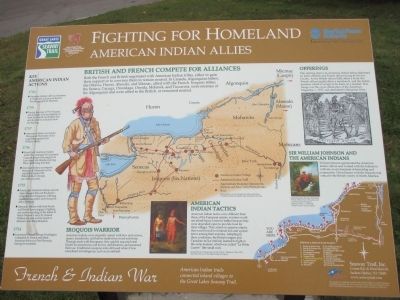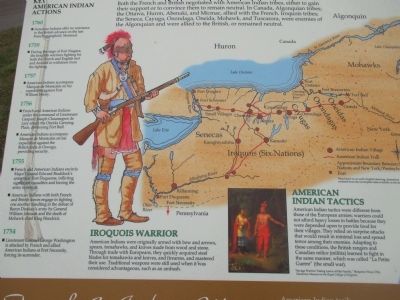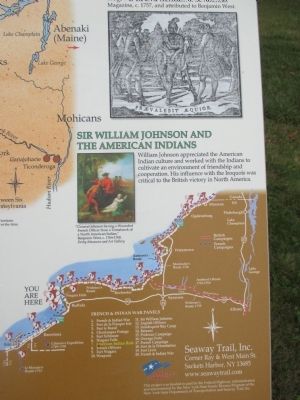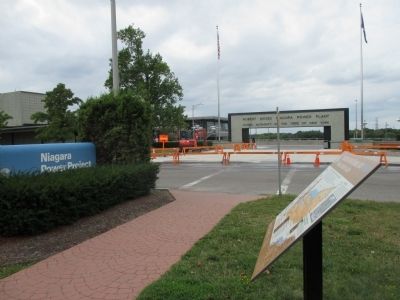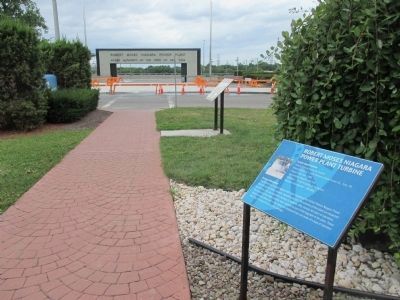Lewiston in Niagara County, New York — The American Northeast (Mid-Atlantic)
Fighting for Homeland
American Indian Allies
— New York State French & Indian War Commemoration - 250 Years —
British and French Compete for Alliances
Both the French and the British negotiated with American Indian tribes, either to gain their support or to convince them to remain neutral. In Canada, Algonquian tribes; the Ottawa, Huron, Abenaki, and Minimac, allied with the French. Iroquois tribes; the Seneca, Cayuga, Onondaga, Oneida, Mohawk, and Tuscarora, were enemies of the Algonquian and were allied to the British, or remained neutral.
Map based on an early English drawing, distortions resulted from the incomplete data available at the time.
Iroquois Warrior
American Indians were originally armed with bow and arrows, spears, tomahawks, and knives made from wood and stone. Through trade with Europeans, they quickly acquired steel blades for tomahawks and knives, and firearms, and mastered their use. Traditional weapons were still used when it was considered advantageous, such as an ambush.
American Indian Tactics
American Indian tactics were different from those of European armies; warriors could not afford heavy losses in battles because they were depended upon to provide food for their villages. They relied on surprise attacks that would result in minimal loss and spread terror among their enemies. Adapting to these conditions, the British rangers and Canadian milice (militia) learned to fight in the same manner, which was called "La Petite Guerre" (the small war.)
"Savage Warrior Taking Leave of His Family."
Benjamin West, 1763. Hunterian Museum at the Royal College of Surgeons.
Sir William Johnson and the American Indians
William Johnson appreciated the American Indian culture and worked with the Indians to cultivate an environment of friendship and cooperation. His influence with the Iroquois was critical to the British victory in North America.
"General Johnson Saving a Wounded French Officer from a tomahawk of a North American Indian," Benjamin West, c. 1764-1768. Derby Museums and Art Gallery.
Offerings:
This etching shows an American Indian being addressed by both a British and French officer trying to win his loyalty. As the British officer (left) offers a book, the French officer (right) offers a tomahawk, and the Indian ponders which to accept as he leans on a musket. This image was the cover illustration of the American Magazine, c. 1757, and attributed to Benjamin West.
Key American Indian Actions
1760
• American Indians offer no resistance to the British advance on the last French stronghold, Montreal.
1759
• During the siege of Fort Niagara, the Iroquois warriors fighting for both the French and English met and decided to withdraw from the fighting.
1757
• American Indians accompany Marquis de Montcalm on his expedition against Fort William Henry. 1756 • French and American Indians under the command of Lieutenant Gaspard Joseph Chaussegros de Lery attack the Oneida Carrying Place, destroying Fort Bull. • American Indians accompany Marquis de Montcalm on his expedition against the British forts at Oswego, providing security.
1755
• French and American Indians encircle Major General Edward Braddock's army near Fort Duquesne, inflicting significant casualties and forcing the army to retreat.
• American Indians with both French and British forces engage in fighting one another resulting in the defeat of Baron Dieskau's army by General William Johnson and the death of Mohawk chief King Hendrick.
1754
• Lieutenant Colonel George Washington is attacked by French and allied American Indians at Fort Necessity, forcing its surrender.
American Indian trails connected inland villages to the Great Lakes Seaway Trail.
Seaway Trail, Inc. Corner Ray & West Main St., Sackets Harbor, NY 13685. www.seawaytrail.com America's Byways. This project was funded in part by the Federal Highway Administration and administered by the New York State Scenic Byways Program of the New York State Department of Transportation and Seaway Trail, Inc.
Erected by Seaway Trail, Inc.
Topics and series. This historical marker is listed in these topic lists: Native Americans • War, French and Indian. In addition, it is included in the Great Lakes Seaway Trail National Scenic Byway series list. A significant historical year for this entry is 1754.
Location. 43° 8.448′ N, 79° 2.306′ W. Marker is in Lewiston, New York, in Niagara County. Marker can be reached from Lewiston Road (New York State Route 104) ¼ mile north of Hyde Park Boulevard (New York State Route 61). Marker is at the loop road at the entrance of the Niagara Power Project Visitors Center. Touch for map. Marker is at or near this postal address: 5777 Lewiston Road, Lewiston NY 14092, United States of America. Touch for directions.
Other nearby markers. At least 8 other markers are within walking distance of this marker. Robert Moses Niagara Power Plant Turbine (a few steps from this marker); Varsity Village (1939), Timon Hall (1952) (about 800 feet away, measured in a direct line); In Memory of Thomas F. Hopkins (approx. 0.2 miles away); Clet Hall, Marillac Hall, Laboure Hall (approx. 0.2 miles away); Alumni Hall / Chapel (approx. 0.2 miles away); For God and Country (approx. ¼ mile away); Dunleavy Hall (approx. ¼ mile away); St. Vincent's Hall (approx. ¼ mile away). Touch for a list and map of all markers in Lewiston.
More about this marker. Parking and admission to the center is free. From NY 104, the driveway is at the pedestrian bridge. The center is north of, and adjacent to, Niagara University.
Also see . . . Niagara Power Project Visitors Center. New York Power Authority website entry:
Location of the marker. (Submitted on September 17, 2014, by Anton Schwarzmueller of Wilson, New York.)
Credits. This page was last revised on January 4, 2022. It was originally submitted on September 17, 2014, by Anton Schwarzmueller of Wilson, New York. This page has been viewed 586 times since then and 23 times this year. Photos: 1, 2, 3, 4, 5. submitted on September 17, 2014, by Anton Schwarzmueller of Wilson, New York. • Bill Pfingsten was the editor who published this page.
